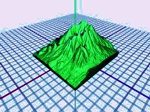

3D printers have been on the market for a number of years. But only in the last few years has their prices dropped – a critical factor supporting increased interest from consumers and businesses.
These printers have several advantages. They can be used to create real, as compared to virtual 3D objects, they support rapid prototyping that allows miniature versions for real objects that can be used for decision making. In addition, 3D objects can be used for communication, advertising and other purpose, that provides interaction with audiences and customers.
There are several manufacturers of 3D printers including Makerbot, Objet, HP, shapeways, Z Corp, Makergear, 3DSystems and others.
In practice, most 3D printing will involve manufactured objects and the design of a wide assortment of object designs. However, landscapes and continuous surfaces (DEM), watersheds, coastal areas, uban planning designs, architecture and other scenarios involving 3D data collected through the use of geomatic tools are also good candidates for 3D printing.
Advancements in the development of surface materials, their placement onto 3D objects, alignment and coloring can now be duplicated in 3D models and printed. This results in eye catching and photo-realistic objects that are highly realistic.
Is a 3D printer in your future? That depends upon what your needs and objectives are, although, many spatial data users today who have traditionally relied upon 2D printer are similarly interested in 3D – particularly for selling their proposals and communication purposes.
And these include road and highway builders, architects, urban planning professionals, plant and energy design projects as well as those considering to re-create underground corridors and utilities that are not readily visible otherwise, but still need to be interpreted and explained.